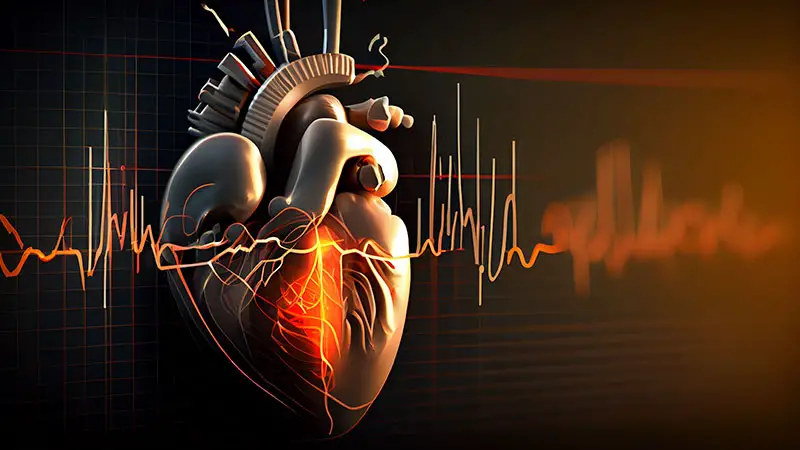Ever felt shaky, dizzy, or unusually hungry out of nowhere? These could be signs of hypoglycemia, a condition characterized by abnormally low blood sugar levels.
Hypoglycemia can affect anyone but is particularly common among individuals with diabetes. Early recognition of its symptoms is vital for timely intervention and effective management.
From sweating and irritability to more severe signs like blurred vision and seizures, understanding these warning signals can help prevent serious health complications.
This blog post will explore the various signs and symptoms of hypoglycemia, helping you to identify and respond to them promptly.
Whether you have diabetes or simply want to be informed, knowing these indicators is crucial for maintaining your health and ensuring swift action when needed. So, stay focused.

What Is Hypoglycemia?
Hypoglycemia, or low blood sugar, occurs when the glucose level in the blood drops below normal. Glucose is a primary energy source for the body, particularly the brain.
Common symptoms include shakiness, sweating, confusion, irritability, dizziness, and in severe cases, unconsciousness or seizures.
Hypoglycemia is often associated with diabetes, particularly in individuals taking insulin or other medications that increase insulin production.
However, it can also result from excessive alcohol consumption, prolonged fasting, certain medical conditions, or hormone deficiencies.
To manage hypoglycemia, individuals can consume quick sources of sugar like glucose tablets, fruit juice, or candy.
For those with diabetes, it’s crucial to monitor blood sugar levels regularly and adjust medications and diet accordingly.
If left untreated, hypoglycemia can lead to serious complications, so recognizing symptoms and acting promptly is essential for maintaining health and preventing emergencies.
Preventing Hypoglycemia
Prevention strategies include the following;
- Consistent Eating Schedule: Eating small, frequent meals can help maintain blood sugar levels.
- Medication Management: Adhering to prescribed medication schedules and doses is crucial.
- Physical Activity: Exercising regularly, but being mindful of the timing and intensity, can help manage blood sugar levels.
- Stress Management: Reducing stress through relaxation techniques can help prevent spikes and drops in blood sugar.
- Medical Check-Ups: Regular visits to a healthcare provider to monitor and adjust treatment plans as necessary.
Hypoglycemia and Lifestyle
Living with hypoglycemia requires careful planning and lifestyle adjustments:
- Wear Medical Identification: Wearing a medical ID bracelet can alert others to your condition in case of an emergency.
- Prepare for Emergencies: Carrying a glucose source at all times ensures you’re ready to address symptoms quickly.
- Communicate with Others: Informing coworkers, friends, and family about your condition can help them support you during an episode.
- Balanced Physical Activity: Engaging in regular physical activity while monitoring blood sugar levels can improve overall health and prevent hypoglycemia.
Regular medical check-ups and personalized care plans are vital for those at risk.
10 Signs and Symptoms of Hypoglycemia
Hypoglycemia, or low blood sugar, can present with various signs and symptoms, ranging from mild to severe. Recognizing these symptoms is crucial for timely intervention and management.
Here are ten common signs and symptoms of hypoglycemia, along with tips for managing and preventing this condition effectively.
1. Shakiness or Tremors

Shakiness or Tremors are often one of the first noticeable signs of hypoglycemia.
The body’s nervous system reacts to low blood sugar levels by releasing hormones like adrenaline, which can cause muscles to twitch or shake uncontrollably.
This reaction is the body’s way of signaling that it needs an immediate intake of glucose. Individuals may notice their hands trembling, making it difficult to perform fine motor tasks such as writing or holding objects steadily.
2. Sweating

Sweating is another common symptom of hypoglycemia, triggered by the autonomic nervous system. When blood sugar levels drop, the body responds by activating sweat glands, particularly on the palms, forehead, and neck.
This excessive sweating can occur even in a cool environment and is often accompanied by a feeling of clamminess. It serves as a physical cue that blood glucose levels need to be checked and addressed promptly.
3. Hunger

Intense Hunger can suddenly strike when blood sugar levels fall too low. This hunger is usually different from normal appetite as it comes on very rapidly and can be overwhelming.
The brain, deprived of its primary energy source, signals the need for immediate food intake, particularly carbohydrates that can quickly raise blood sugar levels. Ignoring this signal can worsen hypoglycemia and lead to more severe symptoms.
4. Dizziness or Lightheadedness

Dizziness or Lightheadedness occurs as a result of the brain not receiving sufficient glucose. This can lead to feelings of unsteadiness, faintness, or a spinning sensation. In severe cases, it can cause the person to faint.
This symptom can significantly impair an individual’s ability to function normally and can be particularly dangerous if it occurs while driving or operating machinery.
5. Confusion or Difficulty Concentrating

Confusion or Difficulty Concentrating happens because the brain relies heavily on glucose for its functions. When blood sugar levels drop, cognitive functions are impaired.
This can manifest as trouble thinking clearly, difficulty focusing on tasks, or a general sense of mental fog. In severe cases, individuals may have trouble remembering things, following conversations, or making decisions.
6. Irritability or Mood Changes

Irritability or Mood Changes are often observed during hypoglycemia. The brain’s response to low glucose levels can affect emotional regulation, leading to sudden irritability, anxiety, or inexplicable mood swings.
People may become unusually short-tempered, impatient, or feel a sense of impending doom without any apparent reason. Recognizing these emotional signs is crucial for timely intervention.
7. Palpitations or Rapid Heartbeat

Palpitations or Rapid Heartbeat can occur as the body releases stress hormones like adrenaline in response to low blood sugar.
This can cause a noticeable increase in heart rate, sometimes described as a fluttering or pounding sensation in the chest.
These symptoms are a clear indicator that the body is under stress due to insufficient glucose, and immediate action is required to normalize blood sugar levels.
8. Blurred Vision

Blurred Vision can result from hypoglycemia due to the lack of glucose affecting the brain and eyes. This symptom can range from slight blurriness to significant vision impairment.
As glucose is essential for proper nerve function, its deficiency can affect the optic nerves and the muscles controlling eye movements.
This can be particularly disorienting and dangerous if the individual is in a situation requiring clear vision.
9. Fatigue and Weakness

Fatigue and Weakness are common when blood sugar levels are low, as the body’s cells, particularly in the muscles and brain, lack the energy needed to perform efficiently.
Individuals might feel unusually tired, weak, or find it hard to stay awake. Physical tasks become more strenuous, and even minimal exertion can lead to exhaustion.
This persistent feeling of fatigue can affect daily activities and overall quality of life.
10. Seizures or Unconsciousness

Seizures or Unconsciousness are severe symptoms of hypoglycemia that require immediate medical attention.
When blood sugar levels drop drastically, the brain’s electrical activity can become abnormal, leading to seizures. In extreme cases, prolonged hypoglycemia can result in loss of consciousness or coma.
These situations are medical emergencies, and timely intervention is crucial to prevent long-term damage or fatality.
Special Considerations
Certain populations may have additional considerations:
- Children and Adolescents: Managing hypoglycemia in young individuals requires careful monitoring and education to recognize symptoms early.
- Pregnant Women: Pregnancy can alter blood sugar levels, necessitating close monitoring and adjustments to treatment.
- Elderly: Older adults may experience more subtle symptoms and require more frequent monitoring and tailored treatment plans.
Understanding and recognizing the signs and symptoms of hypoglycemia is essential for effective management and prevention.
Immediate recognition and treatment can prevent severe complications, while long-term strategies and lifestyle adjustments can help maintain stable blood sugar levels.
By staying informed and proactive, individuals with hypoglycemia can lead healthy and active lives.
Common Causes of Hypoglycemia
Hypoglycemia, characterized by low blood sugar levels, can stem from various causes. Identifying these causes is essential for effective prevention and management.
Here are some common causes of hypoglycemia, ranging from medication use and dietary habits to medical conditions and lifestyle factors, each contributing to the risk of developing this condition.
1. Diabetes Medications
One of the most common causes of hypoglycemia is the use of diabetes medications, particularly insulin and sulfonylureas.
These medications are designed to lower blood sugar levels, but if not managed correctly, they can cause levels to drop too low.
This risk is heightened if doses are too high, meals are skipped, or physical activity is increased without proper adjustments in medication.
2. Skipping Meals or Fasting
Skipping meals or prolonged fasting can lead to hypoglycemia because the body lacks the necessary glucose from food to maintain normal blood sugar levels.
This is especially risky for individuals with diabetes who take medications that lower blood sugar. Without regular intake of carbohydrates, the blood sugar can drop significantly, leading to hypoglycemic symptoms.
3. Excessive Alcohol Consumption
Alcohol can interfere with the liver’s ability to release glucose into the bloodstream. Drinking alcohol, especially on an empty stomach, can result in a significant drop in blood sugar levels.
Chronic heavy drinking can also impair liver function, making it more difficult for the body to regulate blood sugar, increasing the risk of hypoglycemia.
4. Intense Physical Activity
Engaging in intense physical activity can cause hypoglycemia because muscles use more glucose during exercise. If this glucose is not replaced, blood sugar levels can drop.
This is a particular concern for people with diabetes who need to carefully balance their food intake, medication, and physical activity to maintain stable blood sugar levels.
5. Medical Conditions

Certain medical conditions can lead to hypoglycemia. For instance, adrenal insufficiency (Addison’s disease) affects hormone production that regulates blood sugar.
Hypothyroidism can slow metabolism and affect glucose levels. Similarly, pancreatic tumors (insulinomas) can produce excessive insulin, causing blood sugar to drop.
6. Hormonal Imbalances
Hormonal imbalances, such as those involving insulin, glucagon, cortisol, and epinephrine, can disrupt the body’s ability to regulate blood sugar levels.
Conditions that affect these hormones can lead to hypoglycemia by either increasing insulin production or impairing the body’s ability to release glucose into the bloodstream.
7. Reactive Hypoglycemia
Reactive hypoglycemia occurs after eating a meal high in carbohydrates, causing a spike in blood sugar followed by a rapid drop. This overreaction can lead to low blood sugar levels.
It’s often seen in individuals without diabetes and can be managed by eating smaller, more frequent meals that are balanced in macronutrients to prevent rapid spikes and drops in blood sugar.
8. Medications and Illnesses
Certain medications, including some antibiotics, heart medications, and anti-malarial drugs, can cause hypoglycemia. Illnesses that affect the liver, kidneys, or heart can also impair glucose regulation, leading to low blood sugar.
Understanding the common causes of hypoglycemia is crucial for prevention and effective management.
Whether due to diabetes medications, lifestyle factors, or underlying medical conditions, identifying and addressing the root cause can help maintain stable blood sugar levels and prevent hypoglycemic episodes.
Regular monitoring, proper meal planning, and medical guidance are essential components in managing this condition.
Wrapping Up
Understanding the signs and symptoms of hypoglycemia is crucial for timely and effective management.
Recognizing early warning signs such as shakiness, sweating, intense hunger, dizziness, confusion, irritability, fatigue, and severe cases of seizures or unconsciousness can prevent serious complications.
Immediate treatment with fast-acting carbohydrates and regular blood sugar monitoring is essential.
Long-term management involves balanced diets, appropriate medication adjustments, and lifestyle modifications like consistent eating schedules and regular physical activity.
Preventative measures, including stress management and regular medical check-ups, are also vital. For those at risk, educating family and friends and wearing medical identification can ensure quick help during episodes.
By staying informed and proactive, individuals with hypoglycemia can effectively manage their condition, maintaining their health and well-being. Stay focused.
